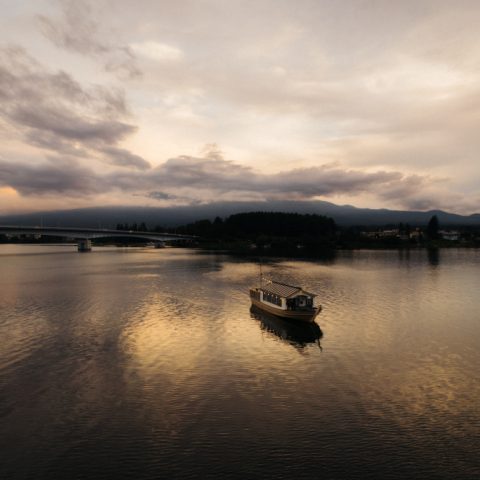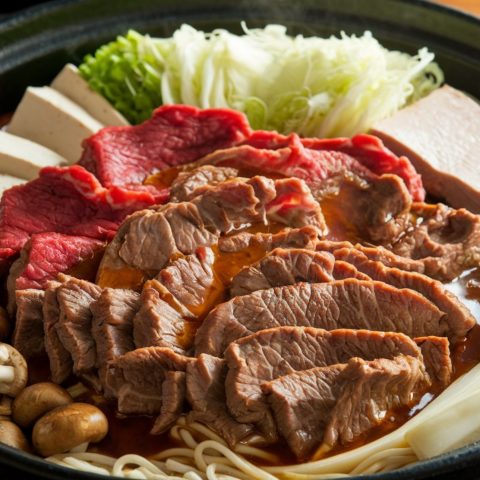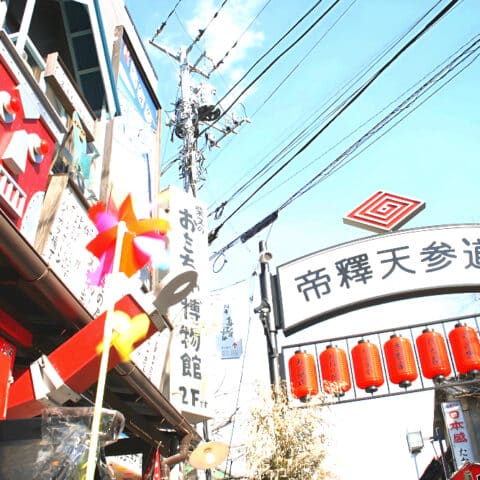
It’s no secret that Japan is one of the centres of the world when it comes to delectable food; the fact that most people can find a Japanese restaurant in their closest town or city is a testament to the popularity of the country’s cuisine. Aside from traditional Japanese cuisine, Japanese foodies and chefs alike are known for their love of international cuisine. Tokyo is famously home to the most Michelin-starred restaurants of any city in the world, with many of these restaurants derived from or solely focused on foreign dishes. Other large cities within Japan, such as Osaka and Kyoto, also boast impressively numerous and eclectic selections of fine eateries. With so much to choose from within these treasure troves of fine dining, it can be easy to either willingly or unknowingly overlook equally exceptional restaurants located in more remote areas of Japan; that’s where The Japan Times and their ‘Destination Restaurants’ come in.

A Tokyo avenue lined with delicious restaurants Credit: Pema Lama
Established in 2021, The Japan Times’ Destination Restaurants is a list of 10 notable restaurants in Japan compiled annually by a group of experts in the field aiming to promote said restaurants to foreign audiences. The list is then scrupulously judged by an erudite trio of culinary connoisseurs, subsequently ranking the restaurants from 1 to 10 via a wide range of criteria.
At this point, I imagine you’re thinking: “Okay, so, what sets this list apart from other similar ones?” Well, the answer to that is that not only are all restaurants within the 23 wards of Tokyo excluded from selection for the list, but also any restaurants located in a city with a population of over 500,000 are banned from inclusion. Naturally, this instantly eliminates a staggering number of fabulous restaurants from selection, which may sound unthinkable for a list of the best restaurants in Japan, but there is certainly a method to this madness. The Japan Times’ goal is not only to shine a spotlight on some of the country’s most noteworthy culinary hidden gems but also to encourage tourists to visit more rural areas of Japan to stimulate the local economies there, hence the inclusion of the word ‘destination’. Furthermore, by visiting these areas, tourists will have an opportunity to immerse themselves in a truly authentic side of Japan that they otherwise may never experience. One of the judges, Naoyuki Honda, said of visiting restaurants in local areas that: “Food prepared by regional chefs is based on the traditional cuisine of the local area, so it is brimming with lived experience and wisdom. I want people not just from overseas but from Japan too to experience that for themselves.” The original Michelin-star guide famously began in a similar vein, i.e., to inspire people to travel farther afield to sample sumptuous food, and we can certainly envisage Destination Restaurants catching on similarly in the coming decades.

Could there be a Michelin-starred restaurant nestled in this unassuming town? Quite possibly! Credit: Tayawee Supan
While we implore you all to take a look at the list in full, along with the comprehensive accompanying articles on each restaurant, we just wanted to highlight a few of the restaurants that we’re chomping at the bit to visit ourselves!
Villa AiDA
It seems only right to start with this year’s undisputed winner, Villa AiDA. Located in Wakayama prefecture, this restaurant can be reached in around 30 minutes by car from Kansai International Airport. It’s indicative of this restaurant’s seclusion that this is the only convenient way to get to it, as although it can be reached by train from Osaka, it is a comparatively long and somewhat convoluted journey involving several transfers. The area that Villa AiDA is in has relatively little of note aside from the restaurant, so most guests simply eat and then return to their home or hotel after their meal. The restaurant itself is inconspicuously nestled among some small shops in a residential neighbourhood and certainly isn’t the place where one would envisage finding anything of interest at first glance, let alone an esteemed restaurant.

Despite its remote location, the restaurant’s incongruous Italian architecture makes it easy to spot Credit: Koutaro Washizaki
Nevertheless, this hasn’t stopped visitors from all over travelling to this remote location to try the carefully crafted dishes made using a variety of succulent homegrown vegetables. The restaurant’s owner and his wife said of these vegetables: “Being here in Wakayama, we can make things you won’t find anywhere else. Over 100 different types of vegetable are grown in the fields around our restaurant. We judge the size and shape of each vegetable and draw out their infinite potential by pairing them properly with other ingredients.”
Vegetables make up around 80 per cent of the dishes served at Villa AiDA, which epitomises the couple’s goals of utilising the gifts bestowed upon them by the fertile fields of Wakayama and fostering an appreciation for health and nature in the process. While we previously stated that there is very little to do in this area, should guests arrive an hour or so earlier than their reservation, they may be able to tour the gardens and greenhouses where the stars of Villa AiDA’s show are devotedly nurtured. We feel that seeing chef Kobayashi and his wife in action tending to their vegetables would give guests a greater understanding of the time, dedication and effort that goes into ensuring that each herb, vegetable or fruit is immaculately grown to ensure the utmost satisfaction for each of their customers.

Vegetables fresh from the garden being carefully prepared Credit: Koutaro Washizaki
As Villa AiDA’s menu makes use of seasonal vegetables, it often changes accordingly, but most menus will consist of one or two omakase (set courses consisting of various dishes selected by the chef) which will invariably include the relevant season’s iconic vegetables. The menu usually includes around 8 to 9 small dishes, two desserts and a sweet served with tea at the end and the current menu starts from 30,800 yen (around $235).

Stunning in both presentation and flavour / Credit: Koutaro Washizaki
Address: 71-5 Kawajiri, Iwade city, Wakayama, 649-6231, Japan
Google maps: https://goo.gl/maps/2UaMChL79FuwSw2v9
Website: http://www.villa-aida.jp/english.html
Chakaiseki Onjaku

Chakaiseki Onjaku’s low-key entrance / Credit: Koutaro Washizaki
Japan is home to many delicious dishes loved around the world, but for many people, Japanese cuisine is particularly synonymous with seafood. Therefore, it seemed only natural to include a restaurant that both respects the traditions of time-honoured Japanese seafood dishes and reimagines them in contemporary ways in order to accentuate their deep flavours: Chakaiseki Onjaku is that restaurant.
This restaurant is located in the coastal city of Yaizu, Shizuoka prefecture, and can be reached in about 30 minutes by car or train from Shizuoka station, which itself is accessible via a roughly 1-hour bullet train ride from Tokyo station. This certainly makes it much easier to get to than Villa AiDA and therefore, naturally, it has grown to become one of the most frequented and admired restaurants outside of Japan’s main cities. Its relative accessibility certainly isn’t the only or even one of the main reasons for its popularity, though. No, the real reason for Chakaiseki Onjaku’s popularity is similar to that of Villa AiDA’s, in that its owner harbours a profound appreciation for the natural bounties of his prefecture and an ardent desire to avail himself of said resources in the preparation of his dishes.

A red snapper being prepared for one of the restaurant’s signature dishes Credit: Koutaro Washizaki
The owner, Daigo Sugiyama, has long been in business with the Sasue Maeda Fish Shop, which is renowned in the culinary world of Japan for supplying top chefs from all over with fresh fish for their dishes. The Sasue Maeda Fish Shop has been supplying Chakaiseki Onjaku with fish since Sugiyama’s grandfather’s days of owning the restaurant, and its current owner, Naoki Maeda, has collaborated closely with Sugiyama to explore the best ways to bring out and complement the deeply diverse flavours of the fish he catches. This has led to the birth of a wealth of intoxicating dishes, including the Red Snapper Grilled with Scales On dish, which has become a mainstay of the menu due to its immense popularity. Like Villa AiDA, only omakase is available and guests can expect to pay 16,500 yen (around $115) for a course diligently curated by the restaurant’s expert chef.

An appetising sample of the omakase course Credit: Koutaro Washizaki
Address: 6 Chome-14-12 Honmachi, Yaizu, Shizuoka 425-0022, Japan
Google Maps: https://goo.gl/maps/7jBAR9v1jJz1BQdv5
Website: http://www.all-yys.com/onjaku/#top
Yoichi Sagra

Yoichi Sagra during Hokkaido’s bitter winter months Credit: Koutaro Washizaki
Finally, for those really wanting to step off the beaten track, we would like to highlight Yoichi Sagra, located on Japan’s northern island of Hokkaido and tucked away in the surroundings of the quaint town of Yoichi. Having visited there several times in the past, I can attest to the fact that Yoichi is a truly rustic town. Despite this, there are actually a few things of note to be found in this quiet little place. For the whiskey lovers reading this, you may be familiar with Yoichi for the fact that it was the birthplace of Nikka Whiskey, one of Japan’s oldest and most esteemed whiskey brands. The first Nikka Whiskey distillery in Yoichi has become something of a museum where guests can learn about Nikka’s whiskey-producing process as well as many fascinating aspects of its founder’s life, who went to Scotland in the early 20th century to study how to make authentic scotch whiskey. Guests can even sample whiskey at the end of the museum, making it a viable option to visit after (or before, for the brave!) making a stop at Yoichi Sagra, giving this particular establishment much better potential for a fruitful day trip than the likes of Villa AiDA.
But anyway, enough about whiskey; let’s talk about wine!

Some of Nikka’s top products on offer at the Yoichi distillery Credit: Changyoung Koh
Aside from whiskey, Yoichi is also known for being the biggest wine producer in Hokkaido, thanks to the fecund fields surrounding the town which facilitate the growth of various fruits, including grapes. Yoichi Sagra is actually an Italian-style inn, perched picturesquely next to a field of wine grapes, where guests can stay for 38,500 yen (around $290) for one night and two meals. Hiroto Murai, the owner and chef at the inn, meticulously tailors each of his dishes to perfectly accompany the seasonal wines from Hokkaido and other parts of Japan. Hiroto Murai, the owner/chef of the inn, meticulously tailors each of his dishes to perfectly accompany the seasonal wines from Hokkaido and other parts of Japan. Guests can also enjoy the omakase course without staying at the inn for 15,000 yen (around $115) and this generally includes about 10 inspired dishes, all of which utilise the region’s abundance of luscious ingredients.

A cosy guestroom at Yoichi Sagra Credit: Koutaro Washizaki
Not satisfied with the inn/restaurant’s current success, Murai plans to offer multi-night experiences targeted at frequent guests in future. Through these experiences, such as kayaking to gather ingredients for the restaurant’s dishes, Murai hopes to expose his guests to the pristine beauty of Hokkaido’s rural reaches, where nature and wildlife remain largely unspoilt. Moreover, Murai wants to ensure that the community around him, for which he holds ample affection, thrives simultaneously with his own business ventures. He is planning to start making sweets from leftover fruit which farmers have been unable to sell, to offer visitors a tasty treat to take home with them and to ensure that the fruits of the local farmers’ labours don’t go to waste.
Address: 987-2 Noboricho, Yoichi, Yoichi District, Hokkaido 046-0002, Japan
Google Maps: https://goo.gl/maps/DeeCem9g5F9DhP4K9
Website: http://sagra.jp/

Yoichi Sagra’s omakase course truly spoils its guest for choice! Credit: Koutaro Washizaki
We hope these previews have given you a glimpse into the exemplary eateries listed in the Destination Restaurants list and that reading about the rest of them will
inspire you to visit some of the lesser-known parts of Japan on your culinary quest! But for those who aren’t quite ready to venture to distant plains, we highly recommend checking out some of our expertly tailored food tours in Japan’s central hubs. How else would you be able to navigate cities such as Tokyo where hidden gems lie on every street corner?! Now, if you’ll excuse me, I have seven trains and three buses to catch to get to Villa AiDA!
Feature photo credit Richard Iwaki
On a trip to Tokyo? Book your local guide to learn more about Japanese food and culture.




